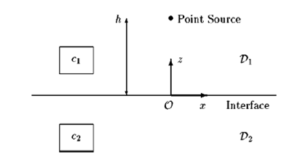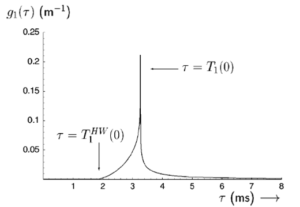Open Journal of Mathematical Sciences
ISSN: 2523-0212 (Online) 2616-4906 (Print)
DOI: 10.30538/oms2020.0103
Reflection wave of a pulsed by a point source
Adel A. S. Abo Seliem
Department of Mathematics, Faculty of Science,University of Kafr El-Sheikh, Egypt.; adel_atta60@yahoo.com
Abstract
Keywords:
1. Introduction
The Dipper effect which manifests itself when the source and the observer are in relative motion [1], when a pulsed wave propagates through an absorbing medium, the interplay of observer in accordance with the principle of consenting causes changes in the spectrum of the wave field [2] and mechanism is scattering by medium, the last two processes and their consequences for the wave field power density spectrum are described in [3,4, 5].
In this paper, we present the study of spectral changes, namely reflection at an interface. The discussion of the pulsed propagation in the two media configuration is carried out with the use of the modified Cagniard technique [6]. This method has bean successfully applied in electromagnetic [7, 8, 9, 10]. In this paper, we consider scalar waves fields. Explicit expressions for the system Green function are obtained and in this configuration the analysis of spectral changes can take place along the lies of the present paper as will. Furthermore, extended sources can be handled with the method as experienced in static dynamic problem as shown in [11].
2. Description of the configuration
The two media configuration under consideration consist of the two and half space as shown in Figure 1. Orthogonal cartesian coordinates \((x,y,z)\) with respect to a fixed reference form are used. The reference frame is chosen such that the half-space and with \(z=0\), the point source is located with \(h\) as positive, the wave function speeds in two media are denoted by \(\varepsilon_{1}(z,\phi,0)\) and \(\varepsilon_{2}(z,\pi,0)\) respectively.Figure 1.
Note: \(R\) and \(T\) remain bounded for all real values of the parameter \(\alpha\) and \(\beta\). Substituting Equations (2), (3) and (4) into Equation (1) tends to the representation of \(u, s\) and taking into account the algebraic factors of \(s\) and \(f(s)\) in the expression (2) - (4), we aim the representation
Figure 2.
Numerical results
The numerical integration and time conversation resulting from the modified Cagniard method wave carried out with the half of the Green function. We first note that the on--cases Green function for the reflected field is now given by \begin{equation*}\label{eqn35} g(0,z,t,\tau )=\frac{1}{4\pi} \frac{R(t)}{z+h} \end{equation*} with \(T(0)\leq \tau \leq \infty\) and equal to \(0\) for \(-\infty \leq \tau \leq T_{1} (0)\). Green function \(G(T)\) for the case \(c1=330\) m/s, \(c2= 150\) m/s the source is at \(z=0,1\) and \(r=0\). Observation point is at \(r=1 m,\ z=0,1 m\) such that this case hand --wave arrival lies at \(T(0)=1.8\) ms and body--wave arrival time \(T(0)=3.3\) ms. In the previous has \(c1\) is largest from \(c1\), upon intersection the two wave speeds head may accordingly can be the case the Green function \(g(T0)\) is given in Figure 2.Conclusion
We calculate the electromagnetic field by a pulsed point source above planar surface, the observed power spectrum depended strongly on the wave speeds, it the two media and on the positive of the observation point with respect to the interface and the source.Acknowledgments
The author would like to express his thanks to the referee for useful remarks.Author Contributions
All authors contributed equally to the writing of this paper. All authors read and approved the final manuscript.Conflict of Interests
The author declares no conflict of interest.References
- Van Bladel, J. (1984). Relativity and engineering, Springer Berlin sec. in particular Chapter 15.[Google Scholor]
- Oughstun, K. E., and Shenon, G. C. (1947). Electomagnetic pluse propagation in central Dielectric, springer, Berlin.
- Wait J. R. (1986). Electromagnetic waves theory, State place New York, Wiley. Chapter 5.
- Hill, D. A., & Wait, J. R. (1981). HF ground wave propagation over mixed land, sea, and sea-ice paths. IEEE Transactions on Geoscience and Remote Sensing, (4), 210-216.[Google Scholor]
- Cagniard, L. (1939). Reflection and refraction of progressive seismic waves (p. Vii). Paris: Gauthier-Villars.[Google Scholor]
- Kuester, E. (1984). The transient electromagnetic field of a pulsed line source located above a dispersively reflecting surface. IEEE transactions on antennas and propagation, 32(11), 1154-1162.[Google Scholor]
- Abo-Seliem, A. A. (1998). The transient response above an evaporation duct. Journal of Physics D: Applied Physics, 31(21), 3046.[Google Scholor]
- Doak, P. E. (1952). The reflexion of a spherical acoustic pulse by an absorbent infinite plane and related problems. Proceedings of the Royal Society of London. Series A. Mathematical and Physical Sciences, 215(1121), 233-254.[Google Scholor]
- Widdet, D.V. (1946). The Laplace transform, Prinleton university press prinecton NJ.[Google Scholor]
- Mandel, L., & Wolf, E. (1995). Optical coherence and quantum optics. Cambridge university press.[Google Scholor]
- I.H.M.T. Van der Hijdem. (1987). Propagation of Transmition electric wave in stratfield, Anisctropic Media (North -- Holand), Amsterdam.


